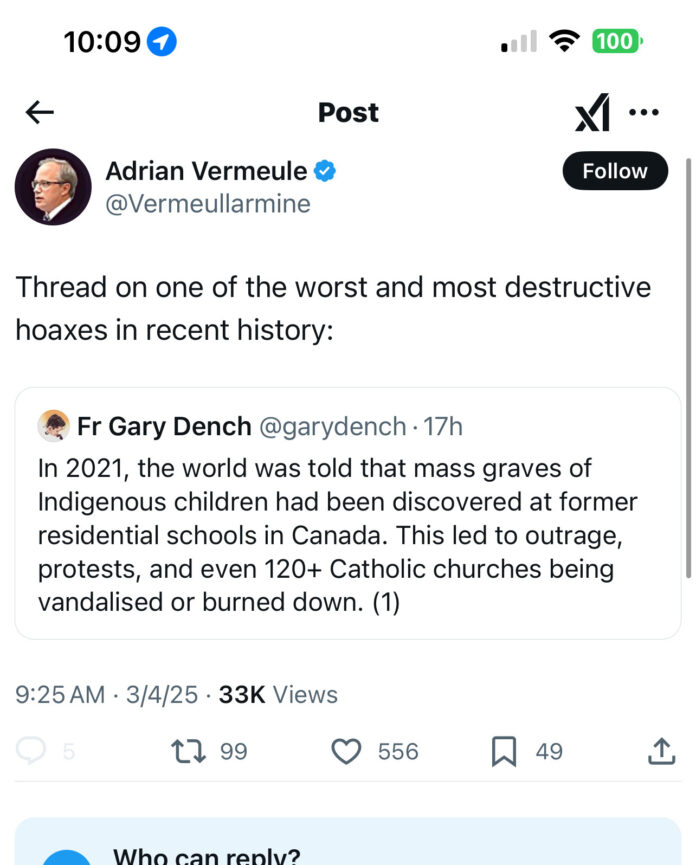
On Tuesday morning, Professor Adrian Vermeule, J.D. ‘93, issued a post on X (formerly known as Twitter) regarding the controversy surrounding First Nations burial grounds in Canadian residential schools. In support of a series of posts by Fr Gary Dench, a Roman Catholic priest from Brentwood, England, Vermeule described the scandal as “one of the worst and most destructive hoaxes in recent history,” referring to the attacks targeting Canadian Catholic institutions following the revelations.
The interaction concerns the decades long saga regarding the treatment of First Nations (term for the indigenous people of Canada) children in Canadian residential schools from the late 19th Century to the closure of the final school in 1997. While there have been several discussions about abuse at the schools and gravesites around them throughout previous decades, culminating in a comprehensive Truth and Reconciliation report by the Canadian government in 2015, it received newfound international attention following the discovery of remains at the Kamloops Indian Residential School in 2021.
The Canadian Museum for Human Rights has described the schools as a “key component” of the Canadian genocide of North American indigenous groups. For a little over a century, First Nations children were forcibly taken from their families and placed in religious schools subsidized by the Canadian government.
Much like American residential schools, these institutions were designed to separate the children from their culture, and assimilate them into Canadian, Christian life. According to the aforementioned report, at least 6,000 children died in these schools, a rate of 1 in 25 children who attended throughout their existence. While many students died from neglect in the face of epidemics during the early decades, between the 1880s and the 1990s various forms of abuse led to traumatization and sometimes death for students. In death, the students were often subjected to differential treatment from the children of staff and missionaries; First Nations’ children were regularly buried in unmarked graves on the property, later discovered decades later through natural decay of their burial grounds or intentional searches for disappeared youths.
While Roman Catholic, Anglican, United, Methodist, and Presbyterian churches ran these schools, about 60% were operated by Catholic administrators. Thus the increased attention in 2021 resulted in the directing of significant opprobrium towards the Roman Catholic Church in Canada and abroad. In 2021, a number of Catholic churches on native land were burned, resulting in denouncements by First Nations representatives and the Canadian government.
In the thread promoted by Professor Vermeule, Fr Dench argues that although the “residential schools were a tragic chapter in Canada’s history,” reactions to the revelations by the public spread “the false narrative that the Catholic Church had secretly buried thousands of Indigenous children in mass graves” and invited several attacks on Catholic institutions since.
In addition to his repost of Fr Dench, Vermeule cited two separate articles. First, he cited a recent article from Catholic Herald stating that “not one grave had been discovered,” taking the lack of exhumations as evidence of the absence of graves on residential property, and connecting the publicity to a spate of vandalism of Catholic churches in Canada. Second, he cited a September 2024 New York Times piece discussing the complexities of removing potential bodies from identified gravesites and growing right-wing skepticism due to the lack of exhumations. The article specifically notes that “there is a broad consensus in Canada that children were taken from their families and died in these schools,” despite the ongoing discussions. Various right-wing outlets have taken recent slashes to funding of the inquiries as a sign that the identification of large unmarked burial plots was a hoax.
Though several First Nations’ residential school gravesites have been detected through other means over the past decades, many are commonly identified through ground-penetrating radar, described by the EPA as “electromagnetic geophysical method that transmits radio wave pulses at select center frequencies into the ground to study the subsurface.” This process is commonly used in criminology and archaeology to locate burial sites, and was recently used in a similar manner to find corpses at the Dozier School for Boys, a Florida reform school that inspired the 2020 Pulitzer Prize winning book Nickel Boys.
“The evidence is clear, there are burials of children on the properties of the former Indian Residential Schools” said Kimberly Murray, National Scholar in Indigenous Legal Studies at Queen’s College and former Independent Special Interlocutor for Missing Children and Unmarked Graves and Burial Sites associated with Indian Residential Schools. Murray was tasked by Canada’s Attorney General and Ministry of Justice with ensuring proper treatment of the burials following the rise in prominence around the issue in 2022.
“Clearly Mr. Vermeule has either not educated himself,” said Murray, “or he is purposely disseminating misinformation and disinformation to attack Indigenous Peoples and Survivors.”

